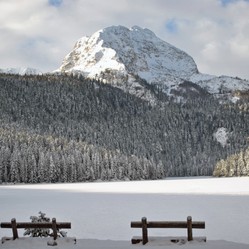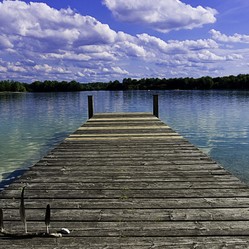A landscape is a piece of inland scenery. Besides such natural features as hills and trees, fields and hedges, a landscape may include water (river, lake, waterfall) and countryside objects forming a part of scenery, like the village church, cottages, inn, farms; also agricultural operations of various kinds, ploughing, harvesting, etc. The appearance of a landscape is affected by natural effects, e.g., sunshine and storm, light and shade, and by the seasons of the year.
The landscape photographer is presented with the raw materials, and he has to make his picture from them. He does so through a selection of viewpoints by movement within the chosen scene, and by a choice of lighting and seasonal conditions suited to his purpose. His object, generally, is to produce a picture portraying some characteristic of the scene or mood of nature, which will also satisfy the eye.
The first thing to consider is the composition, the setting of the item or items of principal interest in the "frame", and the arrangement of the foreground and the sky. Then the lighting must be studied and the time of day for the best effect chosen, although, unless the photographer has unlimited time at his disposal, this may have to be something of a compromise with the viewpoint.
The landscape photographer, particularly if he is on tour, has to make the best of things as he finds them, or note the required conditions and return another day.
Landscape Photography - The Sky
The sky is generally part of any landscape picture, and, in fact, it may provide the main interest. But no matter how much of the picture space it occupies, or whether it plays a principal or secondary part, it must consist of something more than an area of blank paper. Photographic films and plates are almost always over-sensitive to blue light, so unless special precautions are taken, the final print will show no difference in tone between the blue sky and the white clouds. So the sky will be blank and the photograph "baldheaded".
Sky tones can be correctly reproduced, or if necessary exaggerated, in several ways.
1) By using a colour filter that holds back the excess of blue rays;
2) By a special graduated sky filter that filters the light from the sky area only;
3) By printing in clouds from a separate negative during enlargement; or
4) By using a polarizing filter to darken a blue sky. This is a particularly useful method when using colour film, where a coloured filter for such a purpose is obviously out of the question.
Landscape Photography - Figures in Landscapes
Human figures may be included in a landscape photograph, but they should fit naturally into the scene and not be on a big enough scale to become the main interest. Generally speaking, if it is possible to read the expression on the face of any person in the picture, that person will automatically become the subject and the picture will no longer be a landscape study. When people are included, they attract attention out of all proportion to the space they occupy, and a "landscape with figures" is always in danger of becoming "figures with a landscape".
Photographs in towns and cities are apt to look unnatural without people in the streets, but even there, the photographer who includes figures must remember that there is always a strong risk of their stealing the picture.
Landscape Photography - Camera
Any decent camera can successfully by used for landscape photography. For controlling perspective, and giving scope for creative composition, interchangeable lenses are invaluable.
Fixed-focus cameras are not very suitable for open landscapes, because their zone of sharpest focus is generally around 20 to 30 feet and they give very poor definition of very distant parts.
The normal camera lens has a focal length about equal to the length of the diagonal of the negative, i.e: it has an angle of about 53°. This type of lens takes in too much foreground and sky for landscape photography where the interest does not lie nearer than the middle distance. It is better to use a lens of longer focal length, i.e: with a narrower angle of view, so that the near foreground and the upper sky area are cut out and the important part of the scene fills the negative.
Where the camera lens is not interchangeable for one of longer focus, the unwanted foreground or sky can be left out when enlarging the negative, or trimmed off the finished print.
A lens with a shorter-than-normal focal length, i.e: a wide-angle lens, is sometimes used in landscape photography for special effects, such as exaggerating the size of near objects or conveying an impression of spaciousness.
Landscape Photography - Exposure
In open landscape photography the lens is usually stopped down as far as possible to give the maximum sharpness and depth of field.
This means that the shutter speed often is the limiting factor. On calm days it is possible to work at shutter speeds of 1/25th second, or even longer if the camera is on a tripod. But if there is a slight breeze, a shutter speed of at least 1/100th second must be used to prevent the movement of branches and eaves from showing, and on a really windy day, speeds up to 1/500th second may be necessary.
If there are people moving about in the scene, nothing slower than 1/100th second should be used.
The direction of the light falling on the scene must also be considered in conjunction with any exposure aid. As a rough guide, the exposure recommendation should be doubled if the light is shining directly from the side, and multiplied by four when shining towards the camera.
If there is running or falling water in the scene, nothing faster than 1/250th second should be used, or the water will look frozen.








 Photographic Styleon 10/14/2011
Photographic Styleon 10/14/2011
 Interchangeable Lenseson 09/28/2011
Interchangeable Lenseson 09/28/2011
 Negative Blisters and Blemisheson 09/17/2011
Negative Blisters and Blemisheson 09/17/2011
 Photographyon 08/22/2011
Photographyon 08/22/2011


Comments